Cost-Aware Design and Fabrication of New Support Structures in Laser Powder Bed Fusion: Microstructure and Metallurgical Properties
Abstract
:1. Introduction
2. Materials and Methods
2.1. Computer-Aided Design
2.2. Powder Preparation and Fabrication
2.3. Sample Preparation
2.4. Experimental Procedure
2.5. Cost Model
3. Results and Discussion
3.1. XRD and EDS Analysis
3.2. Hardness Analysis
3.3. Microstructural Analysis
3.4. Production Time and Cost Analyses
4. Conclusions
- Despite the presence of the same phases detected by XRD analysis in all the samples, the variation in the position of the diffracted peak angles and thus different lattice sizes were found for the specimens.
- Among the samples fabricated on different types of support, samples with pin-type (PT53G80) and angled-type (AT53G80) supports had the lowest and highest lattice size and therefore more and less level of precipitations, respectively. Also, in terms of geometrical parameters, the highest value of lattice size and the least precipitation level belonged to the sample fabricated on the densest support with higher thickness and less gap value (AT80G80). These observations were attributed to the heat transfer and cooling rate conditions among different types of support structures that arises from variation in the contact area between sample and support.
- It was revealed that the homogeneous or anisotropic behaviors of samples can be tailored using a proper type of support. In terms of the support type, the sample supported by pin-type (PT53G80) had the highest anisotropic behavior ratio among the samples. It was also found out that increasing the gap value as a geometrical parameter leads to more anisotropic behavior.
- The variation of the elements between samples was investigated using EDS Analysis. The lowest and highest Ni percentages were observed for the samples supported by Angled-type (AT53G80) and pin-type support (PT53G80), respectively. Also, increasing the gap increased the Ni content while no specific trend was observed for changing the thickness.
- Hardness of the samples varied among the samples fabricated with different types of support. A high microhardness value of 460.5 HV was achieved in the as-fabricated IN718 sample built on top of a pin support structure. The results were comparable with the LPBF IN718 in the literature for as-fabricated LPBF sample (322 HV) [21], heat-treated LPBF (335 HV), heat-treated plus hot isostatic pressing (478 HV) [37], and as-fabricated wrought and cast (353 HV) [37].
- In terms of geometrical parameters, the sample fabricated with lower thickness support (AT33G80) showed a higher hardness value compared to the one fabricated with thicker support (AT80G80), However, it was observed that the gap value doesn’t affect the hardness value significantly. This variation in hardness value was mainly attributed to the different levels of secondary phases and precipitations between samples.
- Among the samples fabricated with different types of support, the deepest melt pools were observed for the pin-type support (PT53G80).
- Regarding the influence of thickness, a converse relationship was found between the depth of the pools and the thickness value. It was also found out that change in the gap value doesn’t change the dimension of pools considerably.
- Despite the fact that raw material powder seems to be expensive, the actual material cost is less than other consumables as well as machine setup and maintenance.
- Adjusting the support shape and geometry have the potential of enhancing the specimen properties without adding extra cost. Also, it is possible to increase the hardness and reduce the cost simultaneously.
- Samples fabricated with the same support structure but different geometries (e.g., different thicknesses) demonstrate different levels of hardness and different total support costs while having similar total costs.
Author Contributions
Funding
Institutional Review Board Statement
Informed Consent Statement
Data Availability Statement
Acknowledgments
Conflicts of Interest
References
- Lingenfelter, A. Welding of Inconel alloy 718: A historical overview. Superalloy 1989, 718, 673–683. [Google Scholar]
- Metals, S. Inconel Alloy 718. Publication Number SMC-045. Special Metals Corporation 2007. Available online: https://www.specialmetals.com/documents/technical-bulletins/inconel/inconel-alloy-718 (accessed on 5 February 2021).
- Hosseini, E.; Popovich, V.A. A review of mechanical properties of additively manufactured Inconel 718. Addit. Manuf. 2019, 30, 100877. [Google Scholar] [CrossRef]
- Rahman, M.; Seah, W.K.H.; Teo, T.T. The machinability of inconel 718. J. Mater. Process. Technol. 1997, 63, 199–204. [Google Scholar] [CrossRef]
- Thomas, A.; El-Wahabi, M.; Cabrera, J.M.; Prado, J.M. High temperature deformation of Inconel 718. J. Mater. Process. Technol. 2006, 177, 469–472. [Google Scholar] [CrossRef]
- Çam, G.; Koçak, M. Progress in joining of advanced materials. Int. Mater. Rev. 1998, 43, 1–44. [Google Scholar] [CrossRef]
- Liu, F.; Lin, X.; Huang, C.; Song, M.; Yang, G.; Chen, J.; Huang, W. The effect of laser scanning path on microstructures and mechanical properties of laser solid formed nickel-base superalloy Inconel 718. J. Alloys Compd. 2011, 509, 4505–4509. [Google Scholar] [CrossRef]
- Chang, S.-H. In situ TEM observation of γ′, γ ″and δ precipitations on Inconel 718 superalloy through HIP treatment. J. Alloys Compd. 2009, 486, 716–721. [Google Scholar] [CrossRef]
- Izquierdo, B.; Plaza, S.; Sánchez, J.; Pombo, I.; Ortega, N. Numerical prediction of heat affected layer in the EDM of aeronautical alloys. Appl. Surf. Sci. 2012, 259, 780–790. [Google Scholar] [CrossRef]
- Altin, A.; Nalbant, M.; Taskesen, A. The effects of cutting speed on tool wear and tool life when machining Inconel 718 with ceramic tools. Mater. Des. 2007, 28, 2518–2522. [Google Scholar] [CrossRef]
- Thakur, D.G.; Ramamoorthy, B.; Vijayaraghavan, L. Study on the machinability characteristics of superalloy Inconel 718 during high speed turning. Mater. Des. 2009, 30, 1718–1725. [Google Scholar] [CrossRef]
- Farhang, B.; Ravichander, B.B.; Venturi, F.; Amerinatanzi, A.; Moghaddam, N.S. Study on variations of microstructure and metallurgical properties in various heat-affected zones of SLM fabricated Nickel–Titanium alloy. Mater. Sci. Eng. A 2020, 774, 138919. [Google Scholar] [CrossRef]
- Zhang, D.; Feng, Z.; Wang, C.; Wang, W.; Liu, Z.; Niu, W. Comparison of microstructures and mechanical properties of Inconel 718 alloy processed by selective laser melting and casting. Mater. Sci. Eng. A 2018, 724, 357–367. [Google Scholar] [CrossRef]
- Zhang, D.; Niu, W.; Cao, X.; Liu, Z. Effect of standard heat treatment on the microstructure and mechanical properties of selective laser melting manufactured Inconel 718 superalloy. Mater. Sci. Eng. A 2015, 644, 32–40. [Google Scholar] [CrossRef]
- Luo, S.; Huang, W.; Yang, H.; Yang, J.; Wang, Z.; Zeng, X. Microstructural evolution and corrosion behaviors of Inconel 718 alloy produced by selective laser melting following different heat treatments. Addit. Manuf. 2019, 30, 100875. [Google Scholar] [CrossRef]
- Valdez, M.; Kozuch, C.; Faierson, E.J.; Jasiuk, I. Induced porosity in Super Alloy 718 through the laser additive manufacturing process: Microstructure and mechanical properties. J. Alloys Compd. 2017, 725, 757–764. [Google Scholar] [CrossRef]
- Ni, M.; Chen, C.; Wang, X.; Wang, P.; Li, R.; Zhang, X.; Zhou, K. Anisotropic tensile behavior of in situ precipitation strengthened Inconel 718 fabricated by additive manufacturing. Mater. Sci. Eng. A 2017, 701, 344–351. [Google Scholar] [CrossRef]
- Qi, H.; Azer, M.; Ritter, A. Studies of standard heat treatment effects on microstructure and mechanical properties of laser net shape manufactured Inconel 718. Metall. Mater. Trans. A 2009, 40, 2410–2422. [Google Scholar] [CrossRef]
- Jia, Q.; Gu, D. Selective laser melting additive manufacturing of Inconel 718 superalloy parts: Densification, microstructure and properties. J. Alloys Compd. 2014, 585, 713–721. [Google Scholar] [CrossRef]
- Parimi, L.L.; Ravi, G.; Clark, D.; Attallah, M.M. Microstructural and texture development in direct laser fabricated IN718. Mater. Charact. 2014, 89, 102–111. [Google Scholar] [CrossRef]
- Ravichander, B.B.; Rahimzadeh, A.; Farhang, B.; Shayesteh Moghaddam, N.; Amerinatanzi, A.; Mehrpouya, M. A Prediction Model for Additive Manufacturing of Inconel 718 Superalloy. Appl. Sci. 2021, 11, 8010. [Google Scholar] [CrossRef]
- Chlebus, E.; Gruber, K.; Kuźnicka, B.; Kurzac, J.; Kurzynowski, T. Effect of heat treatment on the microstructure and mechanical properties of Inconel 718 processed by selective laser melting. Mater. Sci. Eng. A 2015, 639, 647–655. [Google Scholar] [CrossRef]
- Tucho, W.M.; Cuvillier, P.; Sjolyst-Kverneland, A.; Hansen, V. Microstructure and hardness studies of Inconel 718 manufactured by selective laser melting before and after solution heat treatment. Mater. Sci. Eng. A 2017, 689, 220–232. [Google Scholar] [CrossRef]
- Tillmann, W.; Schaak, C.; Nellesen, J.; Schaper, M.; Aydinöz, M.; Hoyer, K.-P. Hot isostatic pressing of IN718 components manufactured by selective laser melting. Addit. Manuf. 2017, 13, 93–102. [Google Scholar] [CrossRef]
- Wang, X.; Keya, T.; Chou, K. Build height effect on the Inconel 718 parts fabricated by selective laser melting. Procedia Manuf. 2016, 5, 1006–1017. [Google Scholar] [CrossRef] [Green Version]
- Konečná, R.; Kunz, L.; Nicoletto, G.; Bača, A. Long fatigue crack growth in Inconel 718 produced by selective laser melting. Int. J. Fatigue 2016, 92, 499–506. [Google Scholar] [CrossRef]
- Brenne, F.; Taube, A.; Pröbstle, M.; Neumeier, S.; Schwarze, D.; Schaper, M.; Niendorf, T. Microstructural design of Ni-base alloys for high-temperature applications: Impact of heat treatment on microstructure and mechanical properties after selective laser melting. Prog. Addit. Manuf. 2016, 1, 141–151. [Google Scholar] [CrossRef] [Green Version]
- Aydinöz, M.; Brenne, F.; Schaper, M.; Schaak, C.; Tillmann, W.; Nellesen, J.; Niendorf, T. On the microstructural and mechanical properties of post-treated additively manufactured Inconel 718 superalloy under quasi-static and cyclic loading. Mater. Sci. Eng. A 2016, 669, 246–258. [Google Scholar] [CrossRef]
- Strößner, J.; Terock, M.; Glatzel, U. Mechanical and microstructural investigation of nickel-based superalloy IN718 manufactured by selective laser melting (SLM). Adv. Eng. Mater. 2015, 17, 1099–1105. [Google Scholar] [CrossRef]
- Wang, Z.; Guan, K.; Gao, M.; Li, X.; Chen, X.; Zeng, X. The microstructure and mechanical properties of deposited-IN718 by selective laser melting. J. Alloys Compd. 2012, 513, 518–523. [Google Scholar] [CrossRef]
- Tian, Y.; Muñiz-Lerma, J.; Brochu, M. Nickel-based superalloy microstructure obtained by pulsed laser powder bed fusion. Mater. Charact. 2017, 131, 306–315. [Google Scholar] [CrossRef]
- Konecna, R.; Kunz, L.; Nicoletto, G.; Baca, A. Fatigue crack growth behavior of Inconel 718 produced by selective laser melting. Frat. Ed Integrità Strutt. 2016, 10, 31–40. [Google Scholar] [CrossRef] [Green Version]
- Gribbin, S.; Bicknell, J.; Jorgensen, L.; Tsukrov, I.; Knezevic, M. Low cycle fatigue behavior of direct metal laser sintered Inconel alloy 718. Int. J. Fatigue 2016, 93, 156–167. [Google Scholar] [CrossRef]
- Lu, Y.; Wu, S.; Gan, Y.; Huang, T.; Yang, C.; Junjie, L.; Lin, J. Study on the microstructure, mechanical property and residual stress of SLM Inconel-718 alloy manufactured by differing island scanning strategy. Opt. Laser Technol. 2015, 75, 197–206. [Google Scholar] [CrossRef]
- Amato, K.; Gaytan, S.; Murr, L.E.; Martinez, E.; Shindo, P.; Hernandez, J.; Collins, S.; Medina, F. Microstructures and mechanical behavior of Inconel 718 fabricated by selective laser melting. Acta Mater. 2012, 60, 2229–2239. [Google Scholar] [CrossRef]
- Gong, X.; Wang, X.; Cole, V.; Jones, Z.; Cooper, K.; Chou, K. Characterization of microstructure and mechanical property of Inconel 718 from selective laser melting. In Proceedings of the International Manufacturing Science and Engineering Conference, Charlotte, NC, USA, 8–12 June 2015; p. V001T002A061. [Google Scholar]
- Popovich, V.; Borisov, E.; Popovich, A.; Sufiiarov, V.S.; Masaylo, D.; Alzina, L. Impact of heat treatment on mechanical behaviour of Inconel 718 processed with tailored microstructure by selective laser melting. Mater. Des. 2017, 131, 12–22. [Google Scholar] [CrossRef]
- Elahinia, M.; Shayesteh Moghaddam, N.; Taheri Andani, M.; Amerinatanzi, A.; Bimber, B.A.; Hamilton, R.F. Fabrication of NiTi through additive manufacturing: A review. Prog. Mater. Sci. 2016, 83, 630–663. [Google Scholar] [CrossRef] [Green Version]
- Jiang, J.; Xu, X.; Stringer, J. Support structures for additive manufacturing: A review. J. Manuf. Mater. Process. 2018, 2, 64. [Google Scholar] [CrossRef] [Green Version]
- Strano, G.; Hao, L.; Everson, R.M.; Evans, K.E. A new approach to the design and optimisation of support structures in additive manufacturing. Int. J. Adv. Manuf. Technol. 2013, 66, 1247–1254. [Google Scholar] [CrossRef]
- Hildreth, O.J.; Nassar, A.R.; Chasse, K.R.; Simpson, T.W. Dissolvable Metal Supports for 3D Direct Metal Printing. 3d Print. Addit. Manuf. 2016, 3, 90–97. [Google Scholar] [CrossRef]
- Hussein, A.; Hao, L.; Yan, C.; Everson, R.; Young, P. Advanced lattice support structures for metal additive manufacturing. J. Mater. Process. Technol. 2013, 213, 1019–1026. [Google Scholar] [CrossRef]
- Vaidya, R.; Anand, S. Optimum Support Structure Generation for Additive Manufacturing Using Unit Cell Structures and Support Removal Constraint. Procedia Manuf. 2016, 5, 1043–1059. [Google Scholar] [CrossRef] [Green Version]
- Gan, M.X.; Wong, C.H. Practical support structures for selective laser melting. J. Mater. Process. Technol. 2016, 238, 474–484. [Google Scholar] [CrossRef]
- Calignano, F. Design optimization of supports for overhanging structures in aluminum and titanium alloys by selective laser melting. Mater. Des. 2014, 64, 203–213. [Google Scholar] [CrossRef]
- Dias, M.R.; Guedes, J.M.; Flanagan, C.L.; Hollister, S.J.; Fernandes, P.R. Optimization of scaffold design for bone tissue engineering: A computational and experimental study. Med. Eng. Phys. 2014, 36, 448–457. [Google Scholar] [CrossRef] [PubMed]
- Hussein, A.; Yan, C.; Everson, R. Preliminary Investigation on Cellular Support Structures Using SLM Process. In Innovative Developments in Virtual and Physical Prototyping; Taylor & Francis Group: London, UK, 2011. [Google Scholar]
- Mishurova, T.; Cabeza, S.; Thiede, T.; Nadammal, N.; Kromm, A.; Klaus, M.; Genzel, C.; Haberland, C.; Bruno, G. The Influence of the Support Structure on Residual Stress and Distortion in SLM Inconel 718 Parts. Metall. Mater. Trans. A 2018, 49, 3038–3046. [Google Scholar] [CrossRef] [Green Version]
- Kajima, Y.; Takaichi, A.; Nakamoto, T.; Kimura, T.; Kittikundecha, N.; Tsutsumi, Y.; Nomura, N.; Kawasaki, A.; Takahashi, H.; Hanawa, T.; et al. Effect of adding support structures for overhanging part on fatigue strength in selective laser melting. J. Mech. Behav. Biomed. Mater. 2018, 78, 1–9. [Google Scholar] [CrossRef]
- Chen, H.; Gu, D.; Xiong, J.; Xia, M. Improving additive manufacturing processability of hard-to-process overhanging structure by selective laser melting. J. Mater. Process. Technol. 2017, 250, 99–108. [Google Scholar] [CrossRef]
- Liu, Y.; Yang, Y.; Wang, D. A study on the residual stress during selective laser melting (SLM) of metallic powder. Int. J. Adv. Manuf. Technol. 2016, 87, 647–656. [Google Scholar] [CrossRef]
- Kruth, J.-P.; Froyen, L.; Van Vaerenbergh, J.; Mercelis, P.; Rombouts, M.; Lauwers, B. Selective laser melting of iron-based powder. J. Mater. Process. Technol. 2004, 149, 616–622. [Google Scholar] [CrossRef]
- Pinto, F.; Souza Filho, I.; Sandim, M.; Sandim, H. Defects in parts manufactured by selective laser melting caused by δ-ferrite in reused 316L steel powder feedstock. Addit. Manuf. 2020, 31, 100979. [Google Scholar] [CrossRef]
- Pal, S.; Lojen, G.; Kokol, V.; Drstvenšek, I. Reducing porosity at the starting layers above supporting bars of the parts made by Selective Laser Melting. Powder Technol. 2019, 355, 268–277. [Google Scholar] [CrossRef]
- Kuo, Y.-H.; Cheng, C.-C.; Lin, Y.-S.; San, C.-H. Support structure design in additive manufacturing based on topology optimization. Struct. Multidiscip. Optim. 2018, 57, 183–195. [Google Scholar] [CrossRef]
- Cloots, M.; Spierings, A.; Wegener, K. Assessing new support minimizing strategies for the additive manufacturing technology SLM. In Proceedings of the 24th International SFF Symposium-An Additive Manufacturing Conference, Austin, TX, USA, 16 August 20213; pp. 631–643. [Google Scholar]
- Rasband, W.S. ImageJ. National Institutes of Health: Bethesda, Maryland, USA. 2012. Available online: http://imagej.nih.gov/ij/ (accessed on 7 May 2021).
- Ravichander, B.B.; Amerinatanzi, A.; Shayesteh Moghaddam, N. Study on the Effect of Powder-Bed Fusion Process Parameters on the Quality of as-Built IN718 Parts Using Response Surface Methodology. Metals 2020, 10, 1180. [Google Scholar] [CrossRef]
- Ravichander, B.B.; Favela, C.; Amerinatanzi, A.; Shayesteh Moghaddam, N. A Framework for the Optimization of Powder-Bed Fusion Process; SPIE: Long Beach, CA, USA, 2021; Volume 11589. [Google Scholar]
- Ravichander, B.B.; Farhang, B.; Swails, N.; Amerinatanzi, A.; Shayesteh Moghaddam, N. Analysis of the deviation in properties of selective laser melted samples fabricated by varying process parameters. In SPIE Smart Structures + Nondestructive Evaluation %& SS; SPIE: Anaheim, CA, USA, 2020; Volume 11377. [Google Scholar]
- ASTM E92-82: Standard Test Method for Vickers Hardness of Metallic Materials; ASTM International: West Conshohocken, PA, USA, 2003; Volume 82, pp. 1–9.
- NASA Technical Standards System (NTSS); Specification for Control and Qualification of Laser Powder Bed Fusion Metallurgical Processes. 2017. Available online: https://standards.nasa.gov/standard/msfc/msfc-spec-3717 (accessed on 22 August 2021).
- Baumers, M.; Dickens, P.; Tuck, C.; Hague, R. The cost of additive manufacturing: Machine productivity, economies of scale and technology-push. Technol. Forecast. Soc. Chang. 2016, 102, 193–201. [Google Scholar] [CrossRef]
- Seede, R.; Mostafa, A.; Brailovski, V.; Jahazi, M.; Medraj, M. Microstructural and Microhardness Evolution from Homogenization and Hot Isostatic Pressing on Selective Laser Melted Inconel 718: Structure, Texture, and Phases. J. Manuf. Mater. Process. 2018, 2, 30. [Google Scholar] [CrossRef] [Green Version]
- Zhang, F.; Levine, L.E.; Allen, A.J.; Stoudt, M.R.; Lindwall, G.; Lass, E.A.; Williams, M.E.; Idell, Y.; Campbell, C.E. Effect of heat treatment on the microstructural evolution of a nickel-based superalloy additive-manufactured by laser powder bed fusion. Acta Mater. 2018, 152, 200–214. [Google Scholar] [CrossRef]
- Levine, L.E.; Geantil, P.; Larson, B.C.; Tischler, J.Z.; Kassner, M.E.; Liu, W. Validating classical line profile analyses using microbeam diffraction from individual dislocation cell walls and cell interiors. J. Appl. Crystallogr. 2012, 45, 157–165. [Google Scholar] [CrossRef]
- Levine, L.E.; Larson, B.C.; Yang, W.; Kassner, M.E.; Tischler, J.Z.; Delos-Reyes, M.A.; Fields, R.J.; Liu, W. X-ray microbeam measurements of individual dislocation cell elastic strains in deformed single-crystal copper. Nat. Mater. 2006, 5, 619–622. [Google Scholar] [CrossRef] [PubMed]
- Chaturvedi, M.C.; Han, Y.-f. Strengthening mechanisms in Inconel 718 superalloy. Met. Sci. 1983, 17, 145–149. [Google Scholar] [CrossRef]
- Mostafa, A.; Picazo Rubio, I.; Brailovski, V.; Jahazi, M.; Medraj, M. Structure, Texture and Phases in 3D Printed IN718 Alloy Subjected to Homogenization and HIP Treatments. Metals 2017, 7, 196. [Google Scholar] [CrossRef] [Green Version]
- Pröbstle, M.; Neumeier, S.; Hopfenmüller, J.; Freund, L.P.; Niendorf, T.; Schwarze, D.; Göken, M. Superior creep strength of a nickel-based superalloy produced by selective laser melting. Mater. Sci. Eng. A 2016, 674, 299–307. [Google Scholar] [CrossRef]
- Cengel, Y. Heat and Mass Transfer: Fundamentals and Applications; McGraw-Hill Higher Education: New York, NY, USA, 2014. [Google Scholar]
- Nickel Alloy, Corrosion and Heat Resistant, Bars, Forgings, and Rings 52.5Ni 19Cr 3.0Mo 5.1Cb 0.90Ti 0.50Al 19Fe, Consumable Electrode or Vacuum Induction Melted 1775°F (968 °C) Solution and Precipitation Heat Treated, in AMS5663. Available online: https://www.sae.org/standards/content/ams5663 (accessed on 23 July 2021).
- Nickel Alloy, Corrosion and Heat-Resistant, Investment Castings, 52.5Ni-19Cr-3.0Mo-5.1Cb(Nb)-0.90Ti-0.60Al-18Fe, Vacuum Melted Homogenization and Solution Heat Treated, In AMS5383. Available online: https://www.sae.org/standards/content/ams5383 (accessed on 21 July 2021).
- Li, X.; Shi, J.J.; Wang, C.H.; Cao, G.H.; Russell, A.M.; Zhou, Z.J.; Li, C.P.; Chen, G.F. Effect of heat treatment on microstructure evolution of Inconel 718 alloy fabricated by selective laser melting. J. Alloys Compd. 2018, 764, 639–649. [Google Scholar] [CrossRef]
- Cao, G.; Sun, T.; Wang, C.; Li, X.; Liu, M.; Zhang, Z.; Hu, P.; Russell, A.M.; Schneider, R.; Gerthsen, D. Investigations of γ′, γ ″and δ precipitates in heat-treated Inconel 718 alloy fabricated by selective laser melting. Mater. Charact. 2018, 136, 398–406. [Google Scholar] [CrossRef] [Green Version]
- Ingham, B.; Toney, M.F. 1-X-ray diffraction for characterizing metallic films. In Metallic Films for Electronic, Optical and Magnetic Applications; Barmak, K., Coffey, K., Eds.; Woodhead Publishing: Sawston, UK, 2014; pp. 3–38. [Google Scholar] [CrossRef]
- Hakamada, M.; Nakamoto, Y.; Matsumoto, H.; Iwasaki, H.; Chen, Y.; Kusuda, H.; Mabuchi, M. Relationship between hardness and grain size in electrodeposited copper films. Mater. Sci. Eng. A 2007, 457, 120–126. [Google Scholar] [CrossRef]
- Van, D.; Dinda, G.P.; Park, J.; Mazumder, J.; Lee, S.H. Enhancing hardness of Inconel 718 deposits using the aging effects of cold metal transfer-based additive manufacturing. Mater. Sci. Eng. A 2020, 776, 139005. [Google Scholar] [CrossRef]
- Ronneberg, T.; Davies, C.M.; Hooper, P.A. Revealing relationships between porosity, microstructure and mechanical properties of laser powder bed fusion 316L stainless steel through heat treatment. Mater. Des. 2020, 189, 108481. [Google Scholar] [CrossRef]
- Andreau, O.; Koutiri, I.; Peyre, P.; Penot, J.-D.; Saintier, N.; Pessard, E.; De Terris, T.; Dupuy, C.; Baudin, T. Texture control of 316L parts by modulation of the melt pool morphology in selective laser melting. J. Mater. Process. Technol. 2019, 264, 21–31. [Google Scholar] [CrossRef] [Green Version]
- Dong, Z.; Liu, Y.; Wen, W.; Ge, J.; Liang, J. Effect of Hatch Spacing on Melt Pool and As-built Quality During Selective Laser Melting of Stainless Steel: Modeling and Experimental Approaches. Materials 2019, 12, 50. [Google Scholar] [CrossRef] [Green Version]

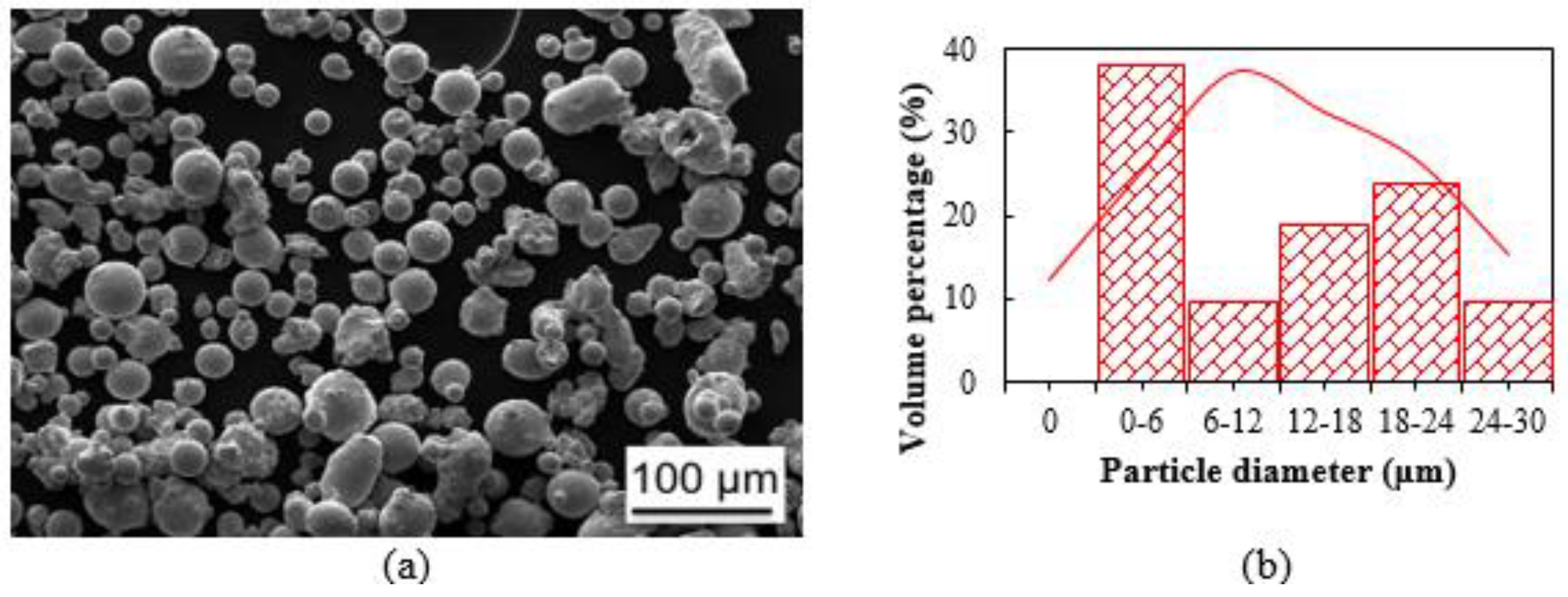
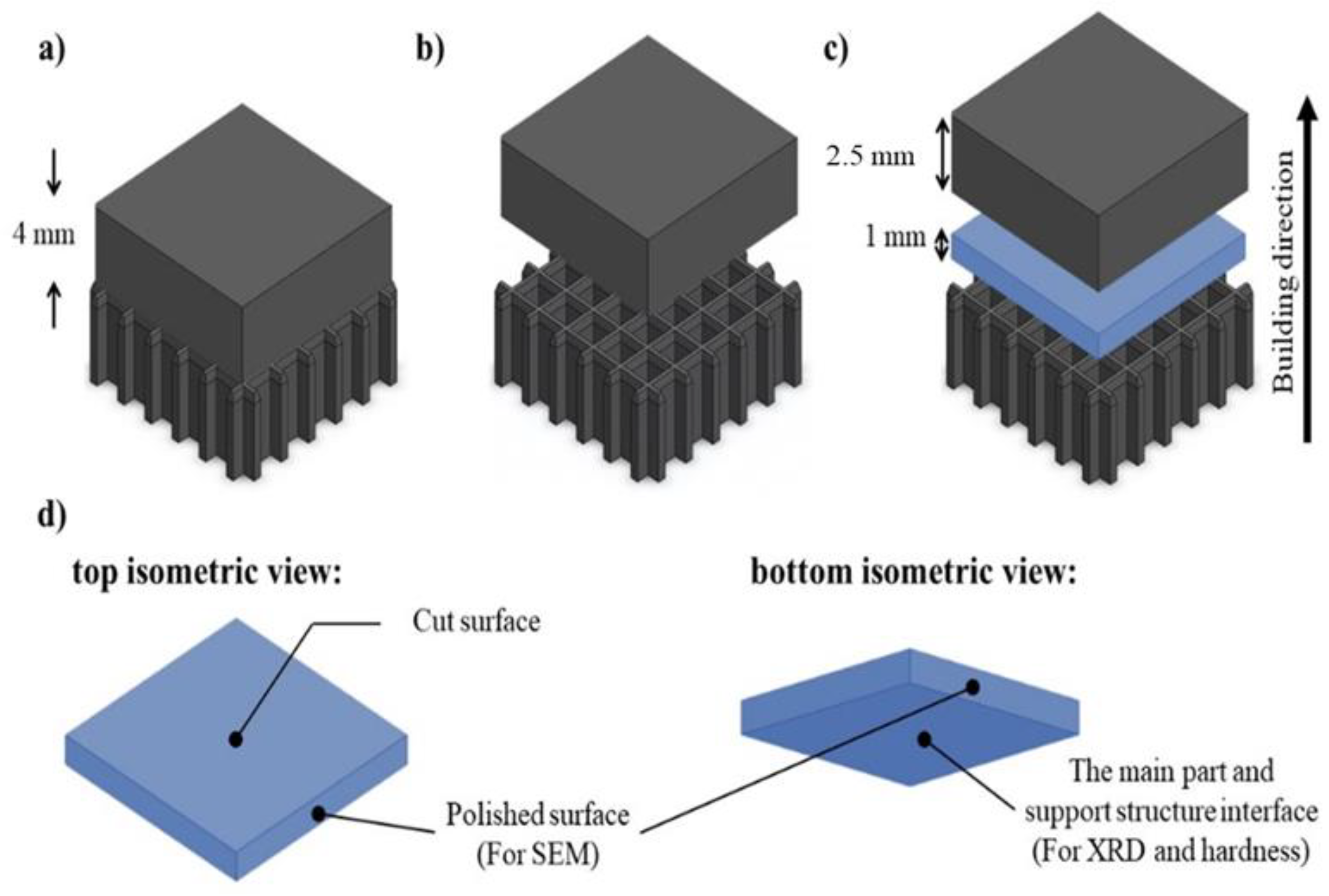
 ; γ, γ′, γ” (200):
; γ, γ′, γ” (200):  ; γ, γ′, γ” (200):
; γ, γ′, γ” (200):  ; γ, γ′(311)/ γ”(033):
; γ, γ′(311)/ γ”(033):  ; and γ, γ′, γ” (200):
; and γ, γ′, γ” (200):  .
.
 ; γ, γ′, γ” (200):
; γ, γ′, γ” (200):  ; γ, γ′, γ” (200):
; γ, γ′, γ” (200):  ; γ, γ′(311)/ γ”(033):
; γ, γ′(311)/ γ”(033):  ; and γ, γ′, γ” (200):
; and γ, γ′, γ” (200):  .
.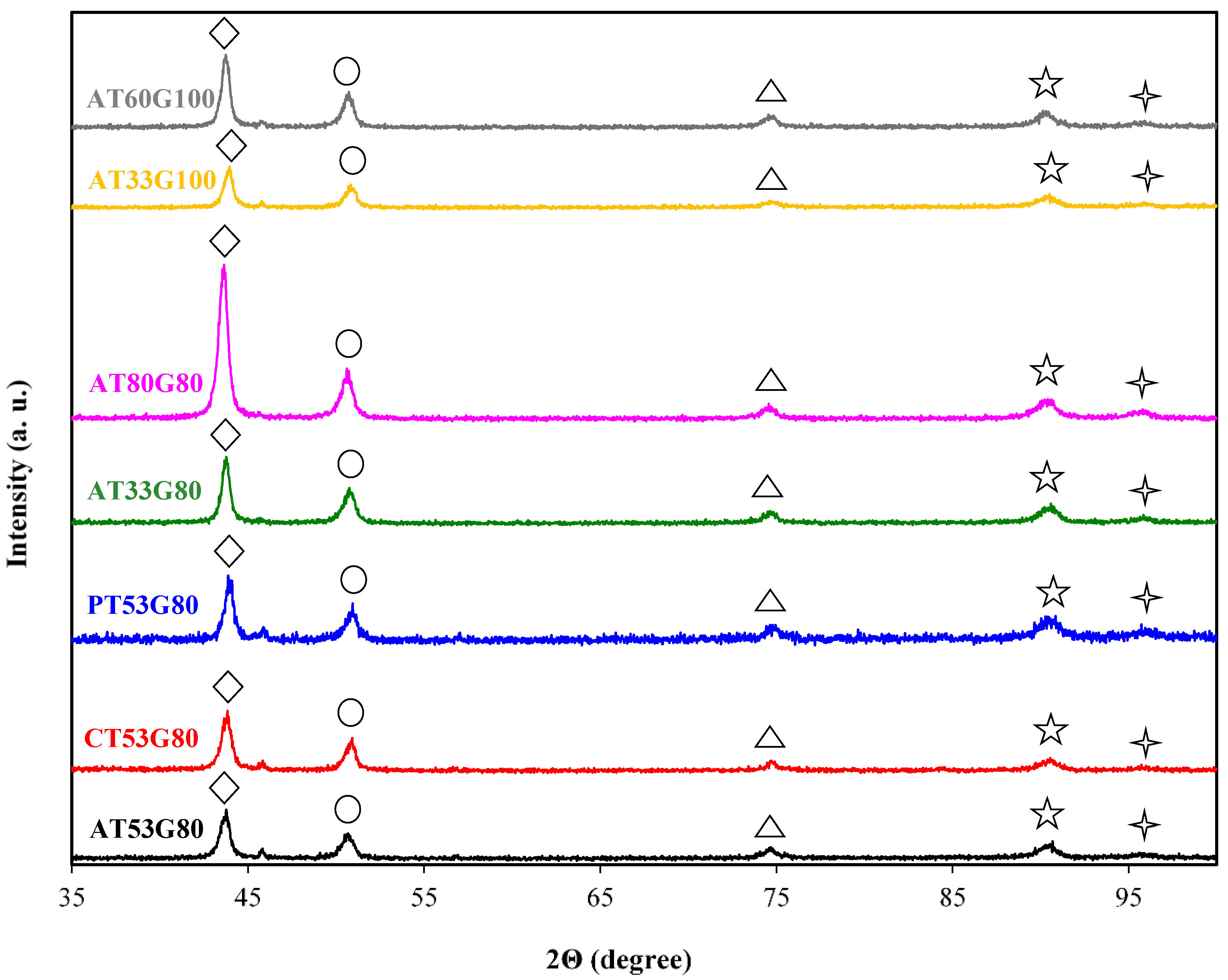
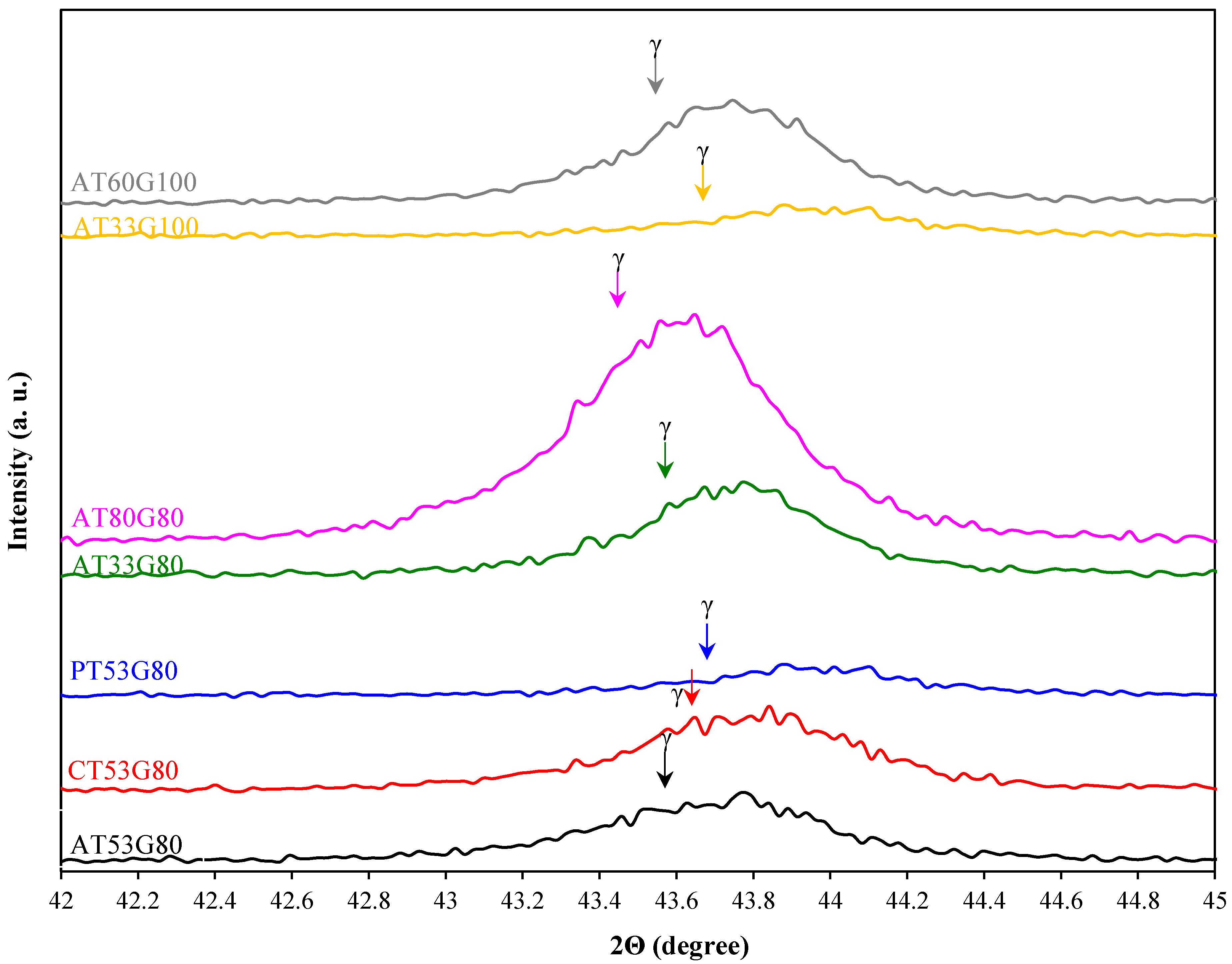
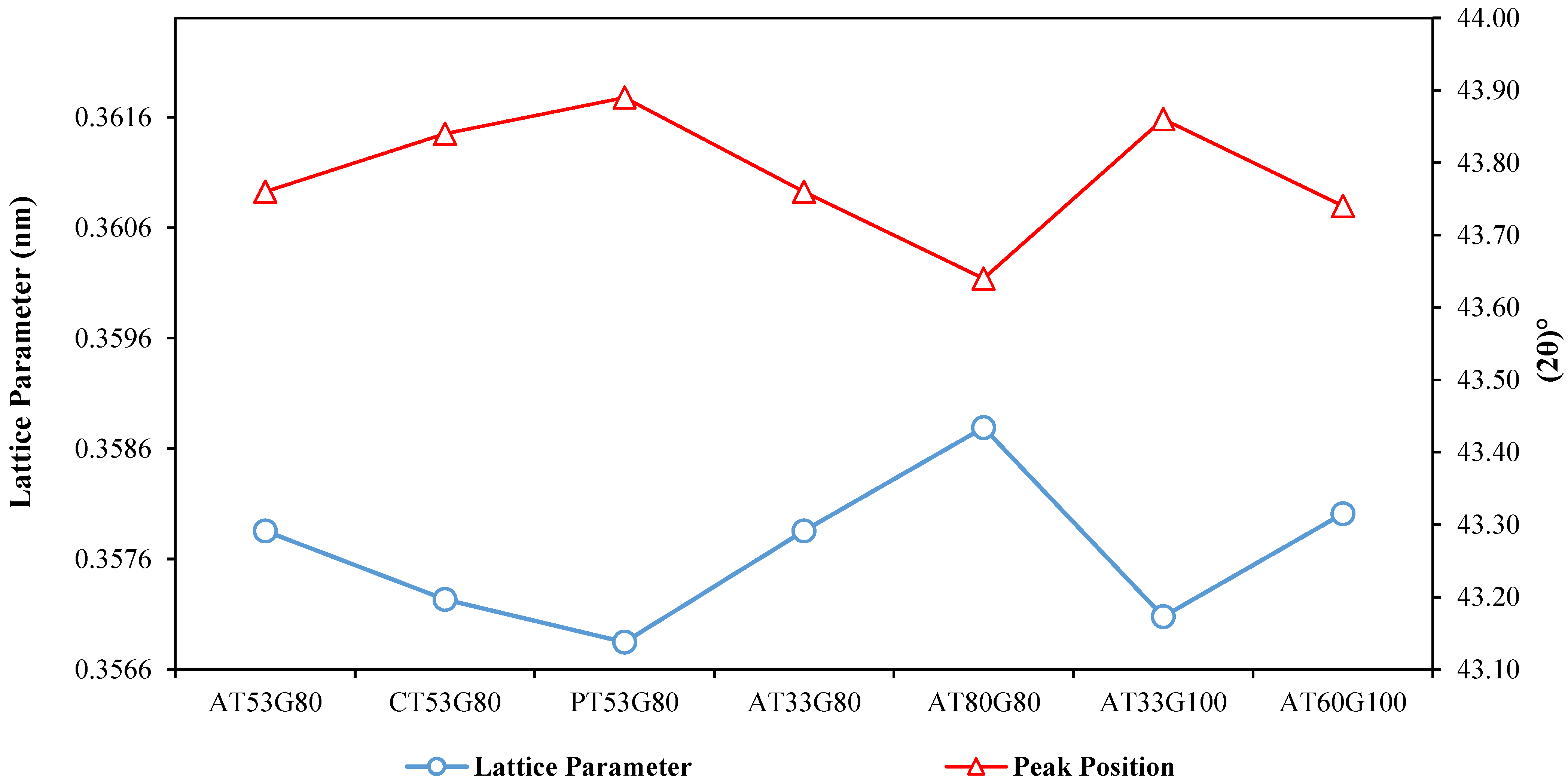
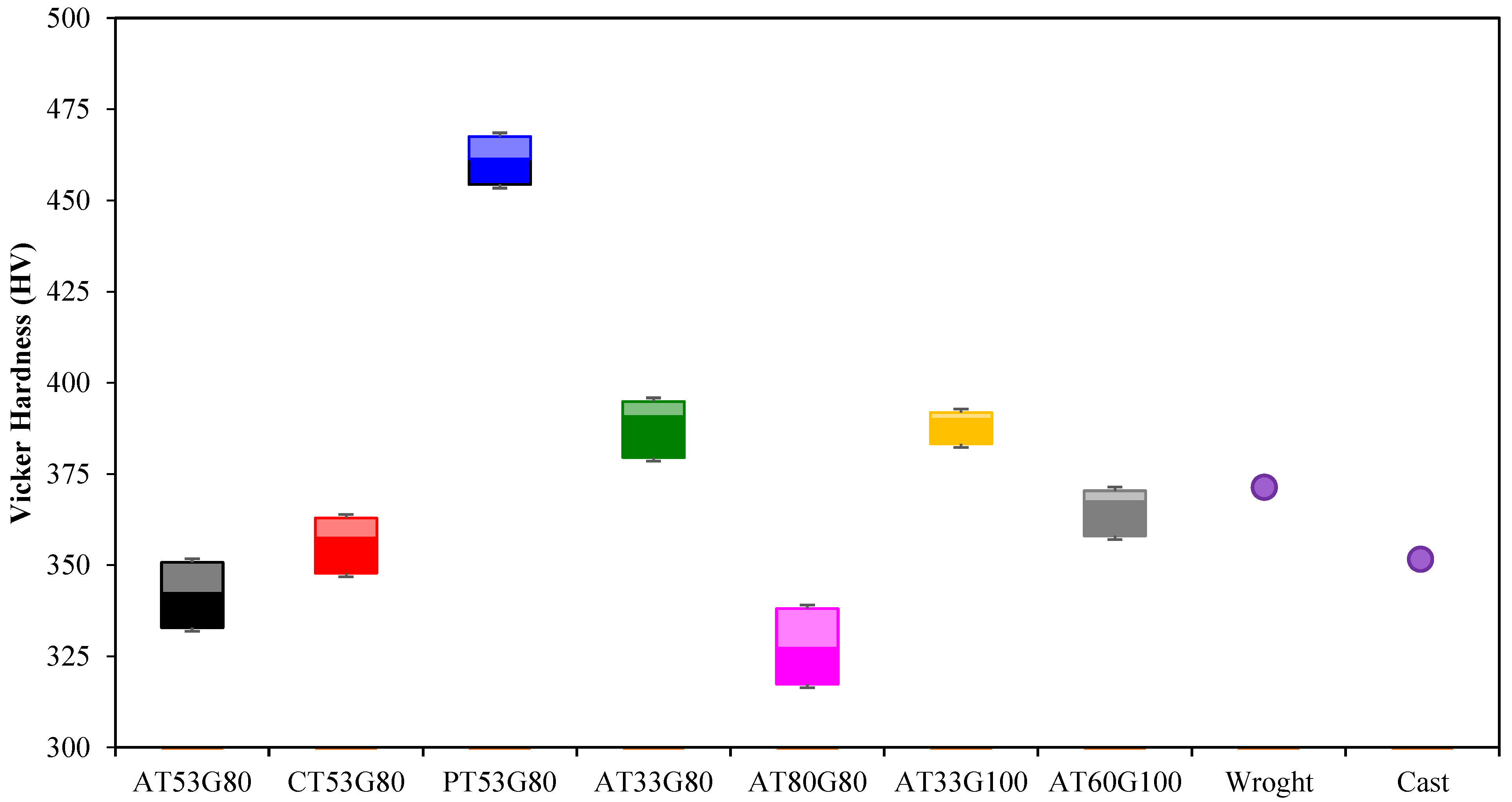

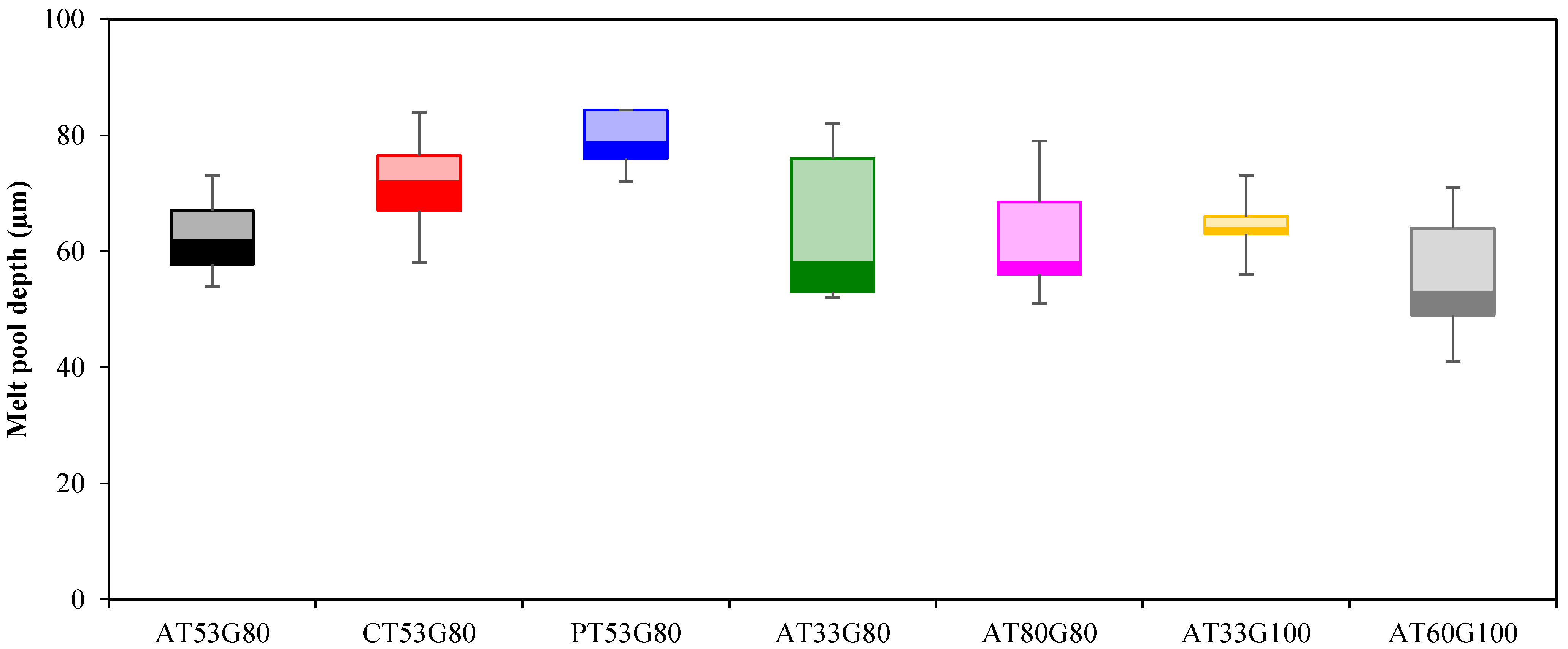
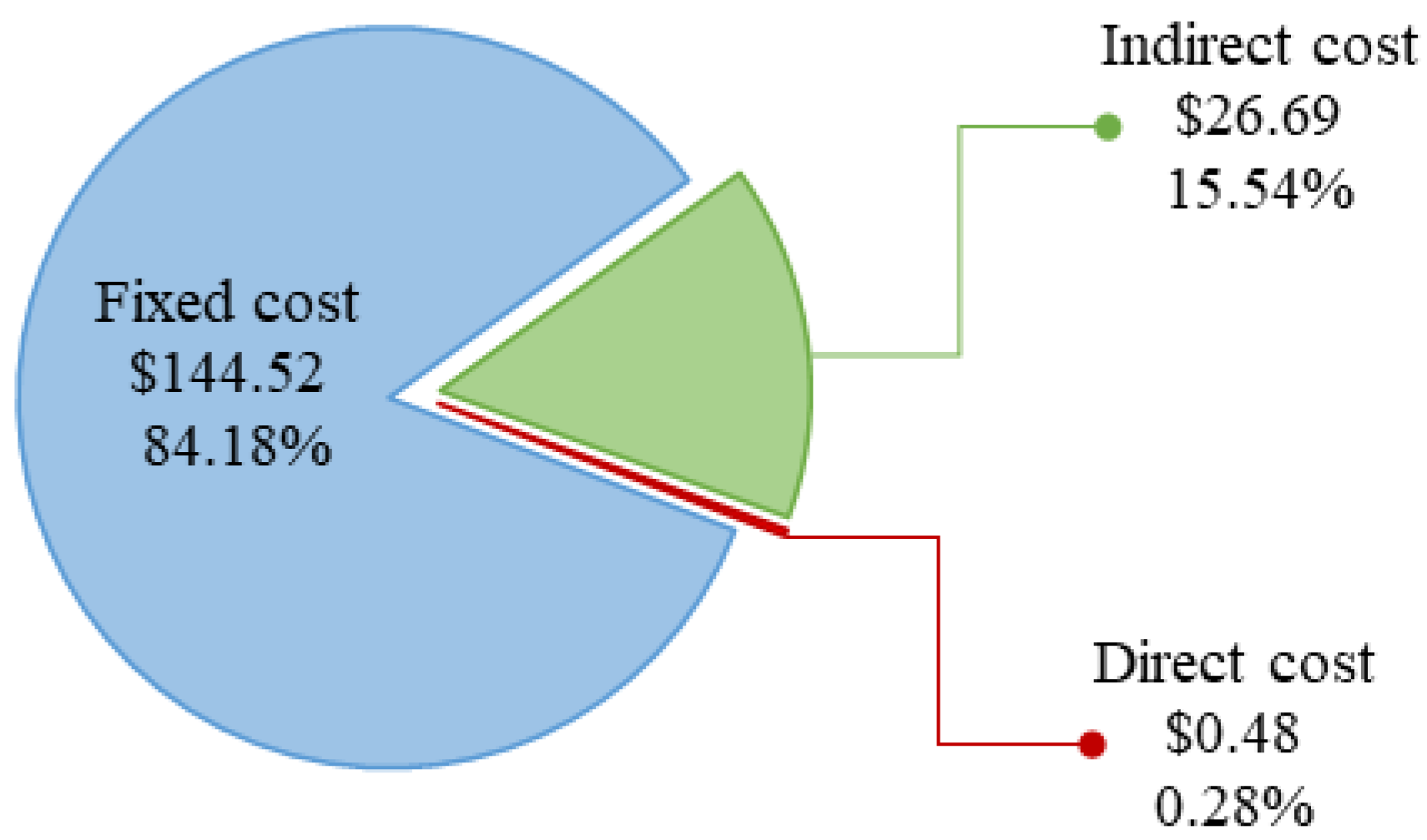
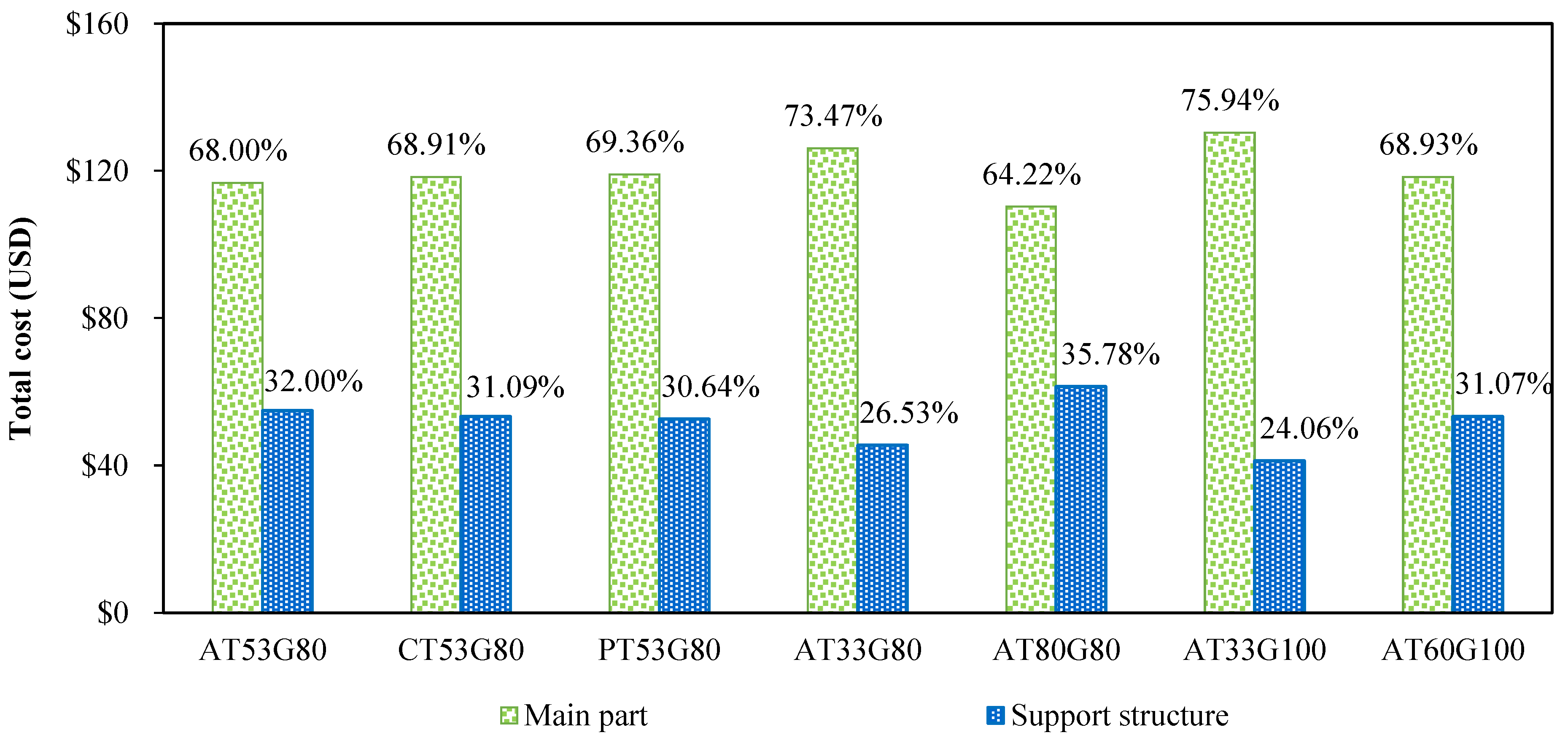
| Sample Number | Support Structure | Thickness (mm) | Gap (mm) | Support Label | CAD Design |
|---|---|---|---|---|---|
| Variation in the type of support structures | |||||
| 1 | Angled | 0.53 | 0.8 | AT53G80 |  |
| 2 | Cone | 0.53 | 0.8 | CT53G80 |  |
| 3 | Pin | 0.53 | 0.8 | PT53G80 |  |
| Variation in the wall thickness of support structures (G = 0.8) | |||||
| 4 | Angled | 0.33 | 0.8 | AT33G80 |  |
| 5 | Angled | 0.8 | 0.8 | AT80G80 |  |
| Variation in the wall thickness of support structures (G = 1) | |||||
| 6 | Angled | 0.33 | 1 | AT33G100 |  |
| 7 | Angled | 0.6 | 1 | AT60G100 |  |
| Symbol | Definition | Values |
|---|---|---|
| Indirect cost | ||
| The cost rate of the compressed air | 0.00 (USD/hour) | |
| The cost rate of Argon gas | 14.77 (USD/hour) | |
| The cost rate of the filters | 0.56 (USD/hour) | |
| The cost rate of the blade | 1.65 (USD/hour) | |
| The capital investment of the AM machine | 125,941.71 (USD) | |
| The useful life of the AM machine | 7 (year) | |
| The occupancy cost rate of the AM machine | 3616.04 (USD/year) | |
| The yearly maintenance cost of the AM machine | 30769.23 (USD/year) | |
| The yearly utilization capability of the AM machine | 4000.00 (hour/year) | |
| The total energy consumption per build | 2.40 (kW) | |
| The electricity price | 0.10 (USD/kWh) | |
| Fixed cost | ||
| The labor hourly salary | 30.77 (USD/hour) | |
| The machine setup time for each build | 3 (hour) | |
| The cost of the build platform | 275.00 (USD) | |
| The maximum number of uses of the build platform | 20 | |
| The refinishing cost of the build platform | 38.46 (USD) | |
| The density of the raw material | 8150.00 (g/mm3) | |
| The material loss rate | 20.00% | |
| Direct raw material cost | ||
| The purchase cost of the raw material | 0.13 (USD/g) | |
| Sample | Top Area (mm2) | Bottom Area (mm2) | Support Volume(mm3) |
|---|---|---|---|
| AT53G80 | 28.18 | 40.77 | 120.46 |
| CT53G80 | 11.30 | 40.77 | 115.49 |
| PT53G80 | 10.08 | 40.77 | 113.11 |
| AT33G80 | 16.87 | 33.20 | 92.43 |
| AT80G80 | 38.69 | 48.00 | 142.63 |
| AT33G100 | 12.97 | 27.76 | 81.10 |
| AT60G100 | 28.00 | 39.00 | 115.11 |
| Sample | Elements | |||
|---|---|---|---|---|
| Ni | Cr | Fe | Ti | |
| AT53G80 | 46.1 | 17.6 | 16.1 | 1.0 |
| CT53G80 | 52.9 | 23.6 | 20.8 | 2.5 |
| PT53G80 | 57.3 | 21.1 | 20.3 | 1.2 |
| AT33G80 | 50.3 | 19.4 | 17.4 | 1.1 |
| AT80G80 | 44.8 | 16.3 | 14.2 | 1.2 |
| AT33G100 | 54.6 | 20.4 | 18.5 | 1.2 |
| AT60G100 | 54.5 | 20.6 | 18.5 | 1.2 |
| Sample | Main Part Volume | Support Volume | Total Volume | Main Part Total Cost | Support Total Cost | Total Cost | Total Fixed Cost | Total Indirect Cost | Total Direct Cost |
|---|---|---|---|---|---|---|---|---|---|
| AT53G80 | 256.0 | 120.46 | 376.46 | 116.75 | 54.94 | 171.69 | 144.52 | 26.69 | 0.48 |
| CT53G80 | 256.0 | 115.49 | 371.49 | 118.31 | 53.37 | 171.68 | 144.52 | 26.69 | 0.47 |
| PT53G80 | 256.0 | 113.11 | 369.11 | 119.07 | 52.61 | 171.68 | 144.52 | 26.69 | 0.47 |
| AT33G80 | 256.0 | 92.43 | 348.43 | 126.12 | 45.53 | 171.65 | 144.52 | 26.69 | 0.44 |
| AT80G80 | 256.0 | 142.63 | 398.63 | 110.27 | 61.44 | 171.71 | 144.52 | 26.69 | 0.51 |
| AT33G100 | 256.0 | 81.10 | 337.10 | 130.24 | 41.29 | 171.63 | 144.52 | 26.69 | 0.43 |
| AT60G100 | 256.0 | 115.41 | 371.41 | 118.33 | 53.35 | 171.68 | 144.52 | 26.69 | 0.47 |
Publisher’s Note: MDPI stays neutral with regard to jurisdictional claims in published maps and institutional affiliations. |
© 2021 by the authors. Licensee MDPI, Basel, Switzerland. This article is an open access article distributed under the terms and conditions of the Creative Commons Attribution (CC BY) license (https://creativecommons.org/licenses/by/4.0/).
Share and Cite
Ravichander, B.B.; Thakare, S.; Ganesh-Ram, A.; Farhang, B.; Hanumantha, M.; Yang, Y.; Shayesteh Moghaddam, N.; Amerinatanzi, A. Cost-Aware Design and Fabrication of New Support Structures in Laser Powder Bed Fusion: Microstructure and Metallurgical Properties. Appl. Sci. 2021, 11, 10127. https://doi.org/10.3390/app112110127
Ravichander BB, Thakare S, Ganesh-Ram A, Farhang B, Hanumantha M, Yang Y, Shayesteh Moghaddam N, Amerinatanzi A. Cost-Aware Design and Fabrication of New Support Structures in Laser Powder Bed Fusion: Microstructure and Metallurgical Properties. Applied Sciences. 2021; 11(21):10127. https://doi.org/10.3390/app112110127
Chicago/Turabian StyleRavichander, Bharath Bhushan, Sourabh Thakare, Aditya Ganesh-Ram, Behzad Farhang, Manjunath Hanumantha, Yiran Yang, Narges Shayesteh Moghaddam, and Amirhesam Amerinatanzi. 2021. "Cost-Aware Design and Fabrication of New Support Structures in Laser Powder Bed Fusion: Microstructure and Metallurgical Properties" Applied Sciences 11, no. 21: 10127. https://doi.org/10.3390/app112110127
APA StyleRavichander, B. B., Thakare, S., Ganesh-Ram, A., Farhang, B., Hanumantha, M., Yang, Y., Shayesteh Moghaddam, N., & Amerinatanzi, A. (2021). Cost-Aware Design and Fabrication of New Support Structures in Laser Powder Bed Fusion: Microstructure and Metallurgical Properties. Applied Sciences, 11(21), 10127. https://doi.org/10.3390/app112110127







